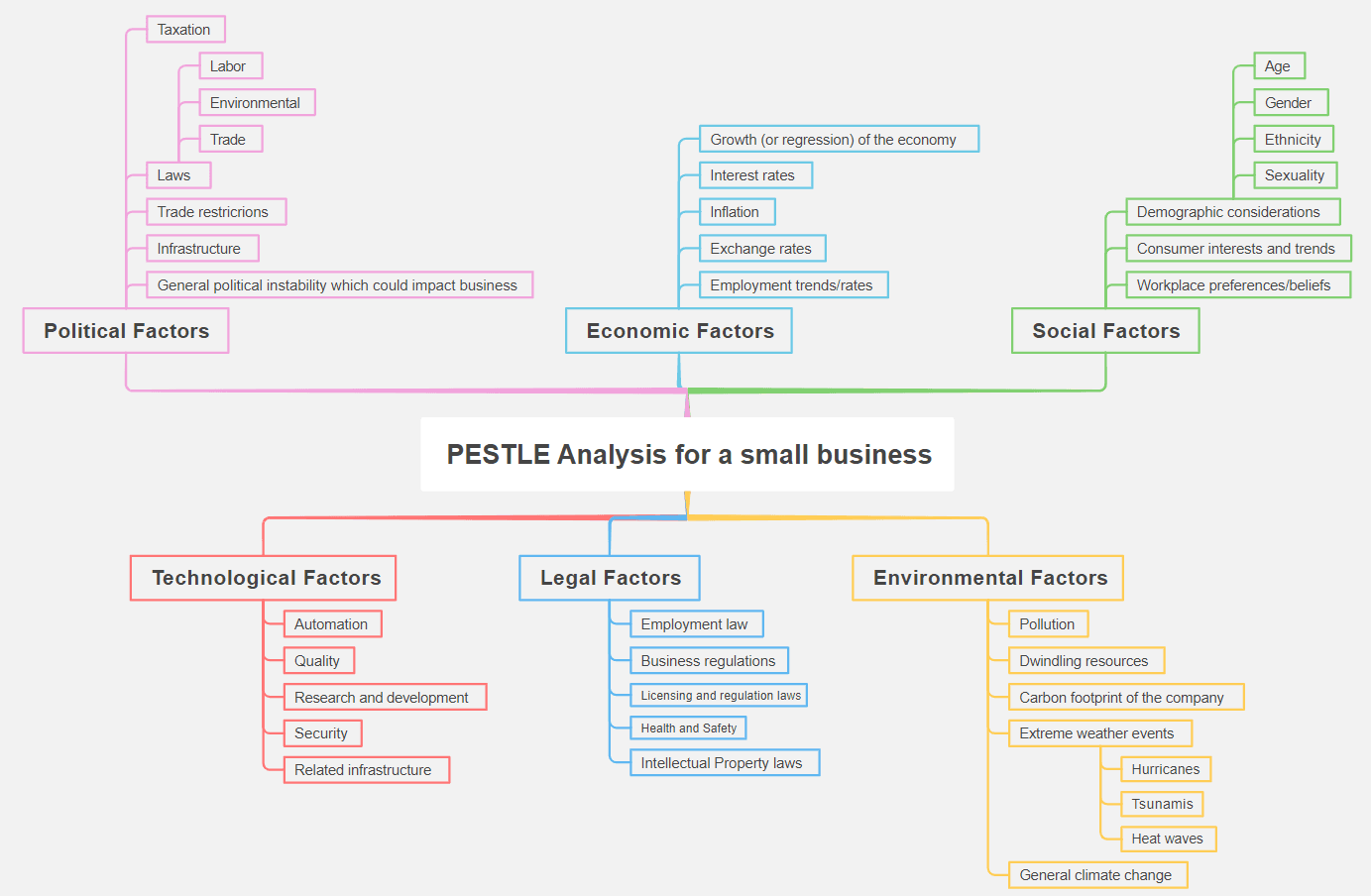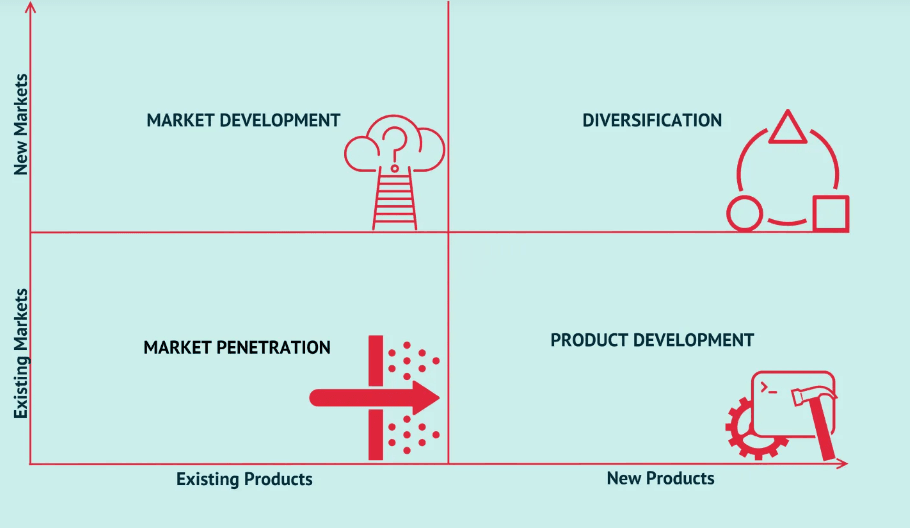What is PESTLE analysis?
A PESTLE analysis is a framework that has been created to analyze and understand wider factors that can have an impact on business. Through this framework, potential weaknesses in the current business plan can be identified and then further broken down in a SWOT analysis. PESTLE is an acronym and stands for the following:
Political
Economic
Social
Technological
Legal
Environmental
Historically, the acronym was just PEST (political, economic, social, technological), but more recent reviews have acknowledged the importance of also understanding the impacts of legal and environmental factors as well. It may also be presented as PESTEL (the acronym still stands for the same words, but legal and environmental have simply been switched).
Who benefits from doing a PESTLE analysis?
The short answer is everyone. PESTLE frameworks are relatively flexible and can be applied to any business from any lens. For example, it might be used by management teams when discussing future strategies. It might be used by financial teams to understand the financial risks of a potential decision.
PESTLE analysis example for a small business
If you are struggling to understand how a PESTLE analysis brings value, we have broken down each component of the acronym and given different examples of how each component might look when analyzed by a small business. This is a general example, but it is likely that different members of an organization will use the framework differently, focusing on their own specialty. It’s important to remember that for the best results, the entire analysis needs to be used, as each aspect can provide valuable insight and can be applied to any business.

Political
This aspect of the framework relates to how the government creates policies that impact businesses/the economy. This includes (but is not limited to) consideration for the following:
- Taxation
- Laws (e.g., labor, environmental, trade, etc.)
- Trade restrictions
- Infrastructure
- General political instability which could impact business
PESTLE example for a small business:
A company is looking to expand to open a new shop in a second location. They want to move to a state/country with a high interest in their produce (as seen from online sales). They note that their intended destination has very high business tax, and they know that the labor laws are different in their current location (e.g., higher minimum wage). After a thorough analysis of these political factors, the business decides to go ahead and expand in the region anyway. They understand the risks and can prepare for them, and their data indicates that the profits made from this location will offset the higher costs.
Economic
This section of the framework pertains to the economic situation, both now and in the future. Generally, the factors that are reviewed in this section are all financial. As identified earlier, different sectors will value different parts of the PESTLE analysis over others. This section is obviously the most important for financial teams and services; however, it should still be used in conjunction with the rest of the framework.
- Growth (or regression) of the economy
- Interest rates
- Inflation
- Exchange rates
- Employment trends/rates
PESTLE example for a small business:
Recent economic trends have been going down, and there are fears of an incoming recession. A small business is offering apprenticeships to people who are looking to retrain into a new career. Their analysis indicates these economic conditions are favorable - there are increasing numbers of people being laid off from work and looking for a new way to make money, and many want to retrain.
Social Factors
Social factors pertain to cultural shifts/habits in regards to lifestyle and health. There are also more objective ways to measure this, with population growth, age/gender/ethnicity/sexuality demographic breakdowns (if this information is available). This data is collated to understand how these social factors impact commercial interest.
- Demographic considerations (age/gender/ethnicity/sexuality/etc.)
- Consumer interests and trends
- Workplace preferences/beliefs
PESTLE example for a small business:
There is a growing interest in sustainability and ethical consumption. A small T-shirt business might find that although it can be more expensive to create a product that has been made ethically (fabric was not made through slave or child labor and comes from sustainable fibers, the staff in the garment factory are paid fairly and work-appropriate shift lengths in a safe environment). However, they find that when they can prove the T-shirt was made ethically and sustainably, their consumers are willing to pay more for the item.
Technological
Technology is rapidly changing and this has a direct effect on almost every single business. It’s important to understand how this can impact a business passively, but also what the introduction of new technology can do to increase productivity. Although there are clear benefits to embracing new and developing technology, it can also mean that smaller businesses struggle to keep up.
- Automation
- Quality
- Research and development
- Security
- Related infrastructure
PESTLE example for a small business:
A small business selling jewelry has made an established name for themselves in a town, and they want to expand. They want to set up a new shop in a different town, but there are obviously high costs associated with such a development. After analysis, they decide to focus on growing their online brand first through wider marketing and developing a better online shopping experience for international customers. Through technology, they are able to develop as a business without needing to physically set up in every place they sell.
Legal
This is one of the aspects of the PESTLE analysis that has been added more recently after a review of the analysis. Legal factors impact how a country operates and how they are allowed to conduct their business. Many businesses find that it may be initially expensive to comply with all of the necessary laws and regulations where they operate; however, the protection this creates will help to avoid future costs with potential lawsuits
- Employment law
- Business regulations
- Licensing and regulation laws
- Health and Safety
- Intellectual Property laws
PESTLE example for a small business:
A food company is looking to purchase a number of large pieces of machinery to help them automate a lot of their food-making processes. They look into the legal processes they would need to follow in terms of health and safety and decide that in order to follow the legal health and safety requirements for such a piece of machinery, they would need to spend more money on more staff and training. They decide to not go ahead with the purchase until they have grown a little more and can afford to comply with all of the regulations.
Environmental
There is a growing understanding that businesses have a strong connection to the physical environment (specifically around them and in general). It is important to understand the effects of a business and what this may mean in the future. Equally, it’s important to research and understand the impacts of environmental conditions beyond the control of the business (e.g., climate change).
- Pollution
- Dwindling resources/sustainability
- Carbon footprint of the company
- Extreme weather events (hurricanes, tsunamis, heat waves)
- General climate change
PESTLE example for a small business:
A boutique tourism agency specializes in providing tourism to a small Pacific island. It is known that due to climate change, sea levels are rising, and this will begin to impact the island significantly in the next decade and beyond. The agency needs to understand what this means for their business model (do they expand to offer tours to other locations?). They also need to consider whether this requires action on behalf of the island, to lobby for climate change support and action to try and undo the effects of global warming.
The aspects of the PESTLE analysis table are not independent.
There is a significant amount of overlap between all of the different components of the PESTLE analysis, so it is important to not think of them as static and separate. For example, global warming and pollution (environmental) have already seen some legal changes be made to the way that businesses operate (legal). Some states now have carbon emission regulations. This means that businesses have to alter their operations to comply with these laws, and this can often mean upgrading to new technology that does not emit as much pollution (technology. For the best results, it’s important for businesses to utilize the whole analysis, not just different components in isolation.
Often the best way to do this is to seek the input of a multidisciplinary team to complete the analysis. This allows each member to focus on their strengths and offer education and information to the rest of the company about the impact that their particular focus will have.





